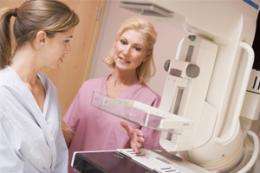Regular mammograms prolong life in breast cancer survivors

Mammography done yearly or every two years to detect new or recurrent tumors after surgery appears to prolong the lives of breast cancer survivors, according to a large new evidence review.
While this will not be surprising to many, in fact “until now there hasn’t been much evidence of benefit for patients,” said lead review author Fiona Gilbert, M.D., a professor of radiology at the University of Aberdeen Medical School, in Scotland. “This study has gone a long way to show that you are justified in doing [surveillance mammography].”
New breast tumors continued to appear up to 10 years after surgery, and their size had a strong effect on survival, the reviewers found.
The review included a survey of 183 surgeons and radiologists across the United Kingdom, data on 32,877 women who had undergone surgery for breast cancer and systematic reviews of 17 studies of nearly 7,500 women that assessed the effectiveness and accuracy of mammography.
Most of the surveyed physicians initiated follow-up mammography a year after mastectomy or breast conserving surgery like lumpectomy, and repeated it yearly or every other year. Most continued follow-up mammography for 10 years, but some did so for five years, and some indefinitely.
The researchers say they hoped to determine which follow-up schedule — how soon after surgery to begin mammography, how frequently to repeat it and how long to continue — would be most effective, “but we didn’t have the data to answer that question. It’s work that needs to be done,” Gilbert said.
The review is published in the latest issue of Health Technology Assessment, the international journal series of the Health Technology Assessment program, part of the National Institute for Health Research in the United Kingdom.
Although it had been thought that cancer in the same or opposite breast would primarily occur within the first two or three years after surgery, the researcher found that in fact tumors kept on coming indefinitely, she said. “We showed that you should not stop [regular mammography] after five years, but continue for at least 10 years.”
It was best to find tumors while they were small, the data showed. Survival was significantly poorer among women whose second tumors were greater than 20 millimeters – a little less than one inch — in diameter, than among those whose tumors were smaller than 10 millimeters.
“Since the only way to find cancers smaller than 10 millimeters is by imaging, this strongly suggests a justification for doing follow-up mammography,” Gilbert said.
One included systematic review that investigated the effectiveness of mammography came to a similar conclusion, suggesting that systematic surveillance with the procedure offered some protection for breast cancer survivors.
Overall, the reviewers concluded, mammography every year or two after surgery seemed to be optimal in helping breast cancer survivors live longer, and clinical examination didn’t add much benefit. A cost-effectiveness analysis similarly found mammography alone to be the best approach.
The authors speculated, however, that that a more fine-tuned approach that tailored follow-up to cancer risk — closer surveillance for women most likely to develop to develop a second tumor, less intense follow-up for those least likely — might use resources most efficiently.
Several of the studies analyzed in the review compared mammography to other imaging methods, and found that MRI was considerably more sensitive in detecting tumors. But research is scant in this area, and there are no direct comparisons to justify this much more expensive approach, Gilbert said.
Stephen Taplin, M.D., a senior scientist at the National Cancer Institute in the United States, said that this “thorough, important study… reflects a change in people’s thought process: It’s not a question of whether women with breast cancer can survive, but how to optimize their lives.”
The findings of the review are unlikely to change practice in the United States, where annual mammography after breast cancer surgery is common. Guidelines published by the American Society of Clinical Oncology support this approach, Taplin said.
But the issues underlying the study, “whether annual mammography is actually beneficial, and what would be optimal surveillance…. those are questions that there are no answers to, and things we need to study,” he said.
Taplin agreed with the researchers that the idea of tailoring surveillance to the patient’s chances of developing a second tumor is worth investigating more closely. He said that the NCI recently funded a major effort to look at the benefits of risk-adjusted breast cancer screening for the general population, “and the idea is perhaps even more appealing in long-term survivors.”
More frequent mammography or adding another imaging method like MRI might improve cancer detection in survivors at higher risk, Taplin said, while less frequent mammography for women at very low risk could minimize problems like radiation exposure and the physical and emotional costs of false positives.
More information: Robertson C, et al. (2011) The clinical effectiveness and cost effectiveness of different surveillance mammography regimens after the treatment for primary breast cancer: systematic reviews, registry database analyses and economic evaluation. Health Technol Assess 2011; Vol.15.













